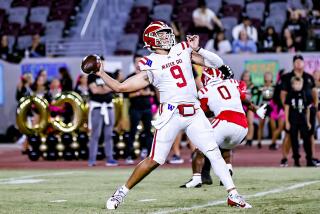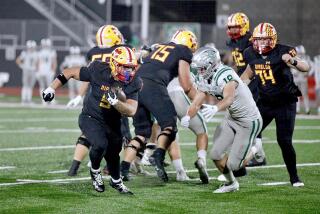Fresno State Leaving Big West to Join WAC : College sports: Bulldogs to switch conferences in 1992. Move could jeopardize future of Division I-A football for Big West schools.
- Share via
Fresno State, the flagship football school in the Big West Conference, announced Wednesday that it will jump to the Western Athletic Conference in the fall of 1992. The move reduces the stature of the Big West and might jeopardize its Division I-A football future.
The Bulldogs’ 19 men’s and women’s athletic teams, which won seven conference championships this past year, will compete in the Big West for one more school year and move into the WAC in 1992-93.
Fresno State had expressed interest in the WAC for several years, but Bulldog Athletic Director Gary Cunningham said he had not been negotiating for membership and was “totally surprised” when the invitation came from the WAC Council of Presidents on Monday.
Fresno State President Harold Haak said he was “delighted” with the move, which will increase the WAC to 10 teams and represents the first change in WAC membership since the Air Force Academy joined in 1980.
“Such membership ensures a stable Division I-A home for all Fresno State sports and offers a future competitive challenge to the Bulldogs,” Haak said.
The Fresno State football team didn’t have a stable Division I-A home in the Big West. With several conference programs, such as Cal State Fullerton and Cal State Long Beach, on shaky financial ground, there has been speculation that some Big West schools will downgrade football to Division I-AA or a proposed I-AAA (non-scholarship) level.
But Big West Commissioner Jim Haney said the conference will remain committed to I-A football.
“Fresno State is a significant member of the conference, but the conference will go on,” Haney said. “We’ll look to improve ourselves as prudently as we can.”
Haney listed Nevada, Boise State, Cal State Northridge and Cal State Sacramento, as possible candidates to replace Fresno, with Nevada the front-runner.
The Wolf Pack, a member of the Big Sky Conference, has had one of the nation’s most successful Division I-AA football programs and went 13-2 last season, losing to Georgia Southern in the I-AA national championship game.
Nevada is in the process of expanding its football stadium from 21,000 to 30,000 seats, and the school also has an 11,800-seat basketball arena. The basketball team finished second in the Big Sky last season.
“We’ve talked to Jim Haney and we’re interested, no question,” said Chris Ault, Nevada’s athletic director and football coach. “Our ties are on the West Coast. It would be much easier travel-wise for us to play in the Big West.”
Haney said Nevada is very interested in the Big West and that Boise State also has shown interest. He said Northridge and Sacramento State would be good candidates, but neither plays Division I football.
Although Northridge has plans to build a 30,000-seat football stadium, Matadores Athletic Director Bob Hiegert said Division I-A football “is not in our immediate plans.
“They told us before that if we had Division I-A football, they’d seriously consider us,” Hiegert said. “But I-A football in the Big West is in serious jeopardy with Fresno out. I hope (the Big West) reconsiders their stand on that.”
The Big West has been able to fulfill the NCAA’s Division I-A football criteria primarily on the strength of Fresno State. The Bulldogs, who are expanding their stadium to 40,000, have regularly averaged 30,000 or more for home games.
Individual schools can meet the criteria by having a 30,000-seat stadium and, once every four years, averaging 20,000 fans for all games or 17,000 for home games. Schools that don’t have the 30,000-seat stadium must average 17,000 for home games. A conference qualifies by having one more than half of its members (five in the Big West) meet the criteria.
The Big West is certified in Division I-A for the next four seasons, but unless the conference can attract a school with a Division I-A-caliber football program, it might not be able to remain Division I after 1994.
Last season, seven of the Big West’s schools ranked 89th or lower among 106 Division I-A teams in home attendance. Fresno State ranked 57th with an average of 32,881.
“Other conference schools have made commitments to I-A football and if we add a school that meets I-A criteria, we’re doing as well as we have in the past,” Haney said. “Losing Fresno certainly hurts, but someone else will have to step up and get it done.”
Nevada has averaged about 17,000 for home games and, if it joins the Big West, it could help the conference maintain its Division I-A status. But it will be difficult to find a school with a better all-around athletic program than Fresno State.
The Bulldogs have won four conference football championships and four California Bowls in the past nine years, their basketball team appears to be on the rise under new Coach Gary Colson, their baseball team is a perennial national power, their track teams have dominated the Big West, and their softball team has been the national runner-up four times in the past 10 years.
“It’s good for Fresno State but it’s not good for the conference from a prestige standpoint,” Fullerton Coach Gene Murphy said. “They have one of the most stable athletic programs on the West Coast.”
Murphy doesn’t believe Fresno’s departure will necessarily signal the end of I-A football in the Big West.
“But if a school in our conference decides to go I-AA or I--AAA, I think some others will follow,” Murphy said. “That’s where you’ll see the snowball effect.”
Haney didn’t rule out the possibility of Big West football programs dropping in classification, “but that’s an issue that each school will have to decide,” he said. “It’s conceivable that a school or two won’t have the resources to stay in I-A, but the majority of our schools are committed to it.”
Added Cal State Long Beach Athletic Director Corey Johnson: “Football is being questioned all across the country. We’ll just have to see.”
Fresno State’s exodus could also be the death knell for the California Raisin Bowl, which annually pits the winners of the Big West and Mid-American Conference in Fresno’s Bulldog Stadium.
There is one year left on the contract with the Big West and MAC, but Neale Stoner, executive director of the bowl, said he has notified the conferences that the game will be an open bowl, with no ties to conferences, by 1992.
“Our only question is, can we find a sponsor who will put up enough money to attract quality teams?” Stoner said. “If we can’t, then our future is in jeopardy.”
Staff writer Mike Hiserman contributed to this story.
More to Read
Go beyond the scoreboard
Get the latest on L.A.'s teams in the daily Sports Report newsletter.
You may occasionally receive promotional content from the Los Angeles Times.











